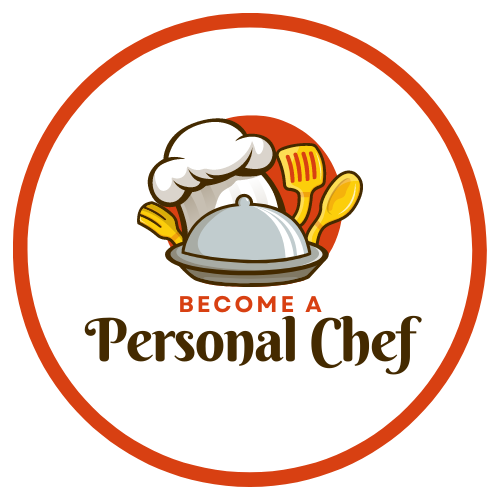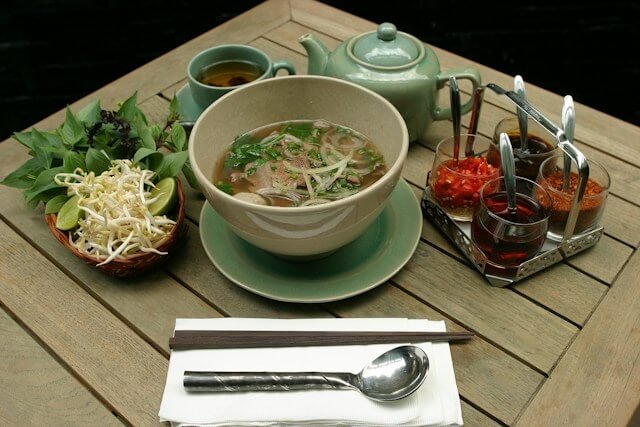Table of Contents
ToggleVietnamese Food for Personal Chefs
As personal chefs, our culinary journey takes us around the globe, exploring different cuisines and flavors. Today, we are venturing into the heart of Southeast Asia to explore the vibrant world of Vietnamese cuisine. Known for its fresh ingredients, bold flavors, and complex dishes, Vietnamese food has gained popularity and is a must-try for any personal chef.
The Basics:
Vietnamese cuisine is heavily influenced by Chinese and French cooking techniques, with an emphasis on using fresh herbs and vegetables. It also incorporates the use of fish sauce, one of the main condiments in Vietnamese cooking. The main staples of a traditional Vietnamese meal are rice or noodles, accompanied by meats or seafood and a variety of vegetables. It’s all about balance – combining meaty, sweet, sour, salty and spicy elements to create harmonious flavors.
Aspiring personal chefs need to offer something different than traditional chefs who specialize in one or two kinds of cuisines. I’ve written an extensive article with links to many cuisines for your consideration – World Cuisine for Personal Chefs
Key Ingredients in Vietnamese Cuisine
Vietnamese cuisine is characterized by its use of fresh, local ingredients that reflect the country’s varied geography and climate.
Some of the key ingredients include fish sauce, oyster sauce, fermented shrimp paste, jasmine rice, noodles, pickled vegetables, Vietnamese cinnamon, various herbs like basil, mint, cilantro, and sawtooth herb, and spices such as star anise, black peppercorns, cardamom, turmeric, bird’s eye chile.
Fish sauce is an essential ingredient in Vietnamese cuisine, used to add depth and umami flavor to dishes. Made from fermented fish, it has a salty and slightly sweet taste that enhances the overall flavor of a dish.
Oyster sauce is another common condiment used in many Vietnamese dishes. It is made from oysters, soy sauce, and sugar, giving it a rich and savory taste that pairs well with meats and vegetables.
Fermented shrimp paste, also known as belacan or mam tom, is often used as a base for soups and sauces. It adds a pungent umami flavor that is characteristic of many Vietnamese dishes.
Jasmine rice is the staple grain in Vietnamese cuisine. Its fragrant aroma and soft texture make it the perfect accompaniment to any meal.
Lemongrass is a popular herb used in many Vietnamese dishes. It has a citrusy, floral flavor that adds freshness and brightness to soups, stir-fries, and marinades.
Vietnamese mint, also known as rau ram or laksa leaf, is a flavorful herb commonly used in salads and noodle dishes. It has a distinct peppery taste that adds a spicy kick to meals.
Basil is another staple herb in Vietnamese cuisine. Known as húng quế, it has a sweet and slightly anise-like flavor that pairs well with meats and vegetables.

Sourcing Ingredients Locally
While many of these ingredients can be found in local supermarkets, some might require a visit to a specialty Vietnamese or Asian grocery store. If certain ingredients are not available locally, suitable substitutes can often be found. It’s important to me to source my ingredients as locally and sustainably as possible, not just for the freshness and quality but also to support local farmers and businesses.
As a personal chef who focuses on using organic and natural ingredients, I take great care in where I source my ingredients from. My goal is to provide my clients with the freshest and most nutritious meals possible while also supporting ethical farming practices.

Traditional Cooking Methods
Vietnamese cuisine employs a variety of cooking methods, with a heavy emphasis on simmering, grilling, stir-frying, and steaming. These traditional techniques are used to create flavorful and nutritious dishes that center around fresh herbs, vegetables, and proteins.
Simmering is a slow-cooking method where food is cooked in liquid at a low temperature. This allows the flavors of the ingredients to meld together, resulting in rich broths and tender meats. In Vietnamese cuisine, simmering is used for soups, stews, and braised dishes such as pho or thit kho (caramelized pork belly).
Grilling is another popular cooking method in Vietnam, especially for meat and seafood. Grilled meats are often marinated beforehand with a combination of spices, herbs, and sauces like fish sauce or soy sauce. This adds depth of flavor while also helping to tenderize the protein.
Stir-frying is a quick and versatile cooking method in Vietnamese cuisine. It involves quickly cooking bite-sized pieces of meat, seafood, or vegetables over high heat in a wok or skillet. The ingredients are constantly stirred to evenly distribute the heat and ensure they don’t stick to the pan. This method results in dishes that are full of vibrant colors, textures, and flavors.
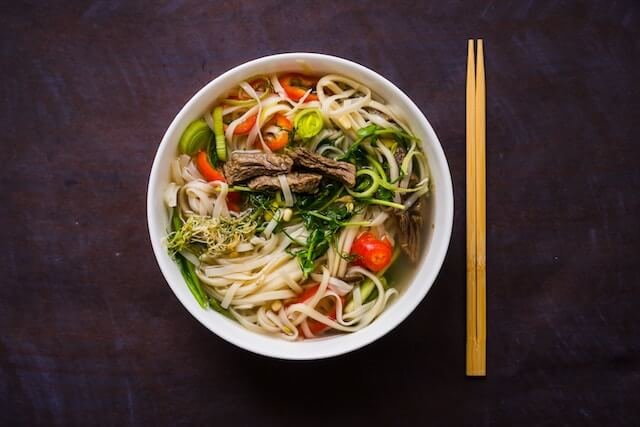
Dominant Flavors of Vietnamese Cuisine
Vietnamese cuisine is known for its balance of five elements associated with five tastes: spicy (metal), sour (wood), bitter (fire), salty (water) and sweet (Earth). The cuisine is known for its fresh, minimalistic approach which helps maintain the integrity of the ingredients. Vietnamese food is also a reflection of its geographical location, with a heavy influence from Chinese and French cuisines due to years of colonization.
One of the dominant flavors in Vietnamese cuisine is fish sauce. This pungent condiment made from fermented fish adds a rich, savory umami flavor to dishes. It is commonly used as a dipping sauce or added to soups and stir-fries for depth of flavor.
Another key ingredient in Vietnamese cuisine is lemongrass. This fragrant herb adds a citrusy, refreshing note to dishes, especially in marinades and soups. Lemongrass is often paired with other herbs like basil and cilantro to create bright and complex flavors.
Chili peppers are another prominent flavor in Vietnamese dishes. While they may not be as spicy as other Southeast Asian cuisines, chili peppers are used in moderation to add a subtle heat and depth of flavor. They can be found in sauces, marinades, and even pickled to add a kick to dishes.
Vietnamese cuisine also heavily utilizes fresh herbs like mint, Thai basil, and cilantro. These herbs are added at the end of cooking or used as garnishes to bring a burst of freshness and color to dishes.
In addition to these dominant flavors, Vietnamese cuisine also incorporates a balance of sweet, sour, salty, and bitter flavors. This is achieved through the use of ingredients like palm sugar for sweetness, lime juice for sourness, and fermented shrimp paste for saltiness.

Spice Level Adjustment
While some Vietnamese cuisine can be spicy, the spice level can usually be adjusted to suit your client’s preference by using less of the spicy ingredient or eliminating it altogether. In Vietnamese culture, it is not uncommon for meals to have a balance between sweet, salty, sour and spicy flavors.
So even if your client prefers less spice, they will still be able to enjoy the full range of flavors in their meal.
One way to adjust the spice level is by using milder chili peppers such as Anaheim or poblano peppers instead of spicier ones like jalapenos or Thai chilies. These peppers still add flavor but with less heat.
Another option is to use dried chili flakes or powder instead of fresh peppers, as they tend to be less intense in terms of spice.
For dishes that call for spicy sauces such as Sriracha or sambal, you can easily adjust the amount used based on your client’s preference. You can also offer alternative options such as a mild hot sauce or a homemade chili paste that allows for more control over the spice level.
Aside from adjusting the spice level, there are other ways to incorporate Vietnamese flavors into your client’s meals without compromising their preferences.
For example, instead of using fish sauce in a dish, which may be too pungent for some clients, you can use soy sauce or tamari as a substitute. These still add depth and umami to the dish without being overpowering.
Another key component of Vietnamese cuisine is fresh herbs and aromatics such as lemongrass, ginger, and basil. When cooking for clients who prefer less spice, incorporating these ingredients can add flavor without adding heat.
These herbs can also be used as toppings or garnishes for dishes, allowing clients to adjust the amount they want in their meals.

Cultural Significance of Vietnamese Cuisine
Vietnamese cuisine has a rich history dating back centuries. It reflects a blend of influences from various cultures, particularly Chinese and French, while maintaining its unique identity.
The cuisine has a distinct balance of flavors, textures, and spices that make it stand out from other Southeast Asian cuisines. In this section, we will explore the cultural significance of Vietnamese cuisine and how it has evolved over time.
Influences from Chinese Cuisine:
Vietnamese cuisine has been heavily influenced by Chinese culinary traditions due to centuries of trade between the two countries. This can be seen in popular dishes such as pho (noodle soup) and banh mi (baguette sandwiches). Both of these dishes have roots in Chinese cooking methods and ingredients, but they have been adapted to suit Vietnamese tastes and preferences.
Influences from French Cuisine:
During the French colonization of Vietnam in the 19th and early 20th centuries, French culinary techniques and ingredients were introduced to Vietnamese cuisine. This fusion resulted in dishes such as banh mi (French baguette with Vietnamese fillings) and ca phe sua da (iced coffee with condensed milk). The French influence can also be seen in the use of dairy products and baking techniques in certain Vietnamese dishes.
Influences from Other Southeast Asian Cuisines:
Due to its geographical location, Vietnamese cuisine has also been influenced by neighboring countries such as Thailand, Cambodia, and Laos. This can be seen in dishes like goi cuon (fresh spring rolls) which are similar to Thai summer rolls, or nem chua (fermented pork rolls) which have similarities to Cambodian somlar machu kroeung (lemongrass and fish soup). These influences have added a diversity of flavors and ingredients to Vietnamese cuisine.
Dietary Considerations
When preparing Vietnamese cuisine, it’s important to consider dietary restrictions. Many Vietnamese dishes can be adapted to be vegetarian or vegan-friendly, and gluten-free options are also available. The key is to communicate your dietary needs with the chef or server, so they can make necessary substitutions or adjustments to the dish.
Vegetarian Options
Vietnamese cuisine offers a variety of meat-free options that are still flavorful and satisfying. Vegetable-based dishes like stir-fried bok choy, crispy tofu, and fresh spring rolls filled with vegetables and herbs are popular choices. You can also ask for meat to be substituted with tofu or tempeh in dishes like pho or banh mi sandwiches.
Vegan-Friendly Choices
For those following a vegan diet, Vietnamese cuisine has plenty of options as well. Many dishes use coconut milk instead of dairy, making them naturally vegan-friendly. Some popular vegan dishes include lemongrass tofu vermicelli bowls, vegetable curry, and vegan banh mi sandwiches with tofu and pickled vegetables. Don’t be afraid to ask your server or the chef for recommendations or substitutions to make a dish vegan.
Gluten-Free Options
If you have a gluten intolerance or allergy, you may think that Vietnamese cuisine is off-limits. But fear not, there are plenty of gluten-free options available. Many dishes use rice noodles instead of wheat noodles and soy sauce can be substituted with tamari, which is a gluten-free alternative. Popular gluten-free dishes include pho with rice noodles, grilled meats and seafood served with steamed rice, and fresh spring rolls wrapped in rice paper.
Allergy-Friendly Cuisine
Vietnamese cuisine also caters to those with other dietary restrictions and allergies. Many dishes can be made without nuts, dairy, or shellfish upon request. Just inform your server or the chef of your allergy and they will do their best to accommodate you. And with most dishes being made fresh to order, you can have peace of mind knowing that your meal is free from any potential allergens.

Health Considerations
Vietnamese cuisine is considered healthy due to its emphasis on fresh fruits and vegetables, lean proteins, and minimal use of dairy and oil. The use of herbs and spices also adds additional health benefits to the dishes.
However, it is important to note that not all Vietnamese dishes are automatically healthy.
Some traditional Vietnamese dishes may contain high amounts of sodium, sugar, or unhealthy oils. So for individuals with dietary restrictions or health concerns, it is important to communicate this to your personal chef when planning your menu.
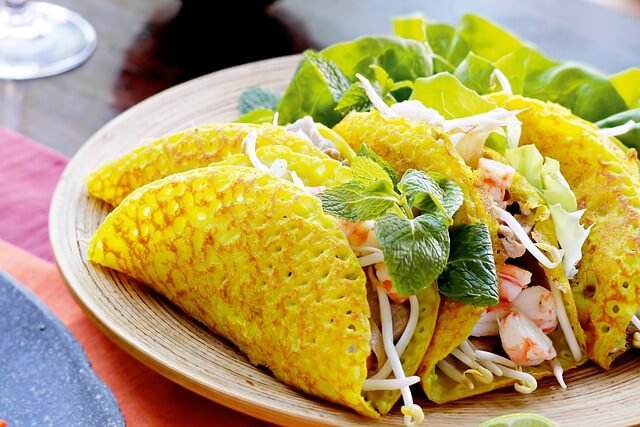
Traditional Accompaniments
A traditional Vietnamese meal often includes a variety of dishes served with rice or noodles. Desserts often feature fresh fruits and sticky rice, while popular drinks include Vietnamese iced coffee and tea. These traditional accompaniments add unique flavors and textures to the meal, making it a satisfying and well-rounded dining experience.
Rice is an essential element of Vietnamese cuisine and serves as the foundation for many dishes. It can be served plain or flavored with herbs, spices, or coconut milk. Sticky rice is often used in sweet dishes or used to make rice cakes, a popular dessert in Vietnam.
Noodles are another staple in Vietnamese cuisine and are used in a variety of dishes such as soups, stir-fries, and salads. Rice noodles (pho) are commonly found in pho soup – a popular street food in Vietnam. Egg noodles (mì) are often stir-fried with vegetables and meat or seafood for a flavorful noodle
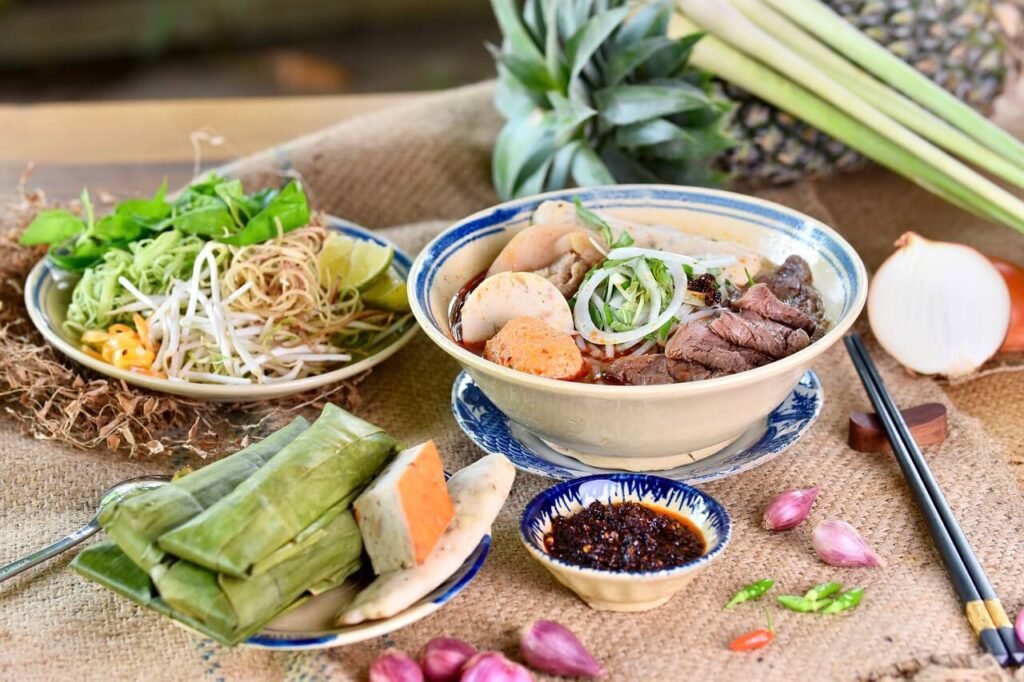
Presentation
In Vietnamese cuisine, the presentation is simple and elegant, with an emphasis on the vibrant colors of the fresh ingredients themselves rather than elaborate garnishes. This reflects the philosophy of using only the best quality, seasonal ingredients in each dish.
Taste
Vietnamese cuisine is known for its balance of flavors and textures. Each dish incorporates a combination of sweet, sour, salty, and spicy elements, creating a harmonious taste experience. The use of fresh herbs and spices adds depth to the dishes and enhances the overall flavor profile.
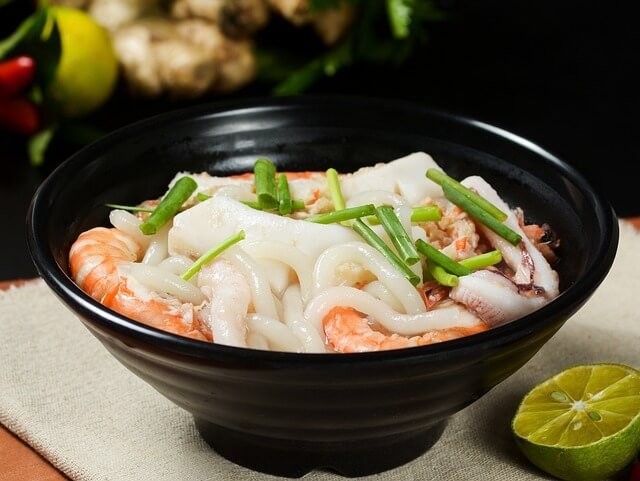
Common Variation
Vietnam’s diverse regions each have their unique flavors and dishes. For example, the Northern region is known for its Chinese influences, the Central region for its spicy cuisine, and the Southern region for its sweeter and bolder flavors. However, one common variation that can be found throughout the country is the use of fresh, organic ingredients in traditional dishes.
Preparation and Equipment
Some Vietnamese dishes may require specific equipment, like a pho pot for making pho or a rice cooker for perfect jasmine rice. Certain elements of a dish, like marinated meats or soaked legumes, may need to be prepared ahead of time.
Here’s a list of cooking equipment commonly used in the preperation of Vietnamese Food:
Phở Pot: A large pot used for making phở broth, a staple in Vietnamese cuisine.
Wok: Essential for stir-frying a variety of dishes, from vegetables to meats.
Bánh Mì Pan: A special pan used for baking the crispy, airy baguettes for bánh mì sandwiches.
Rice Cooker: Rice is a staple in Vietnamese cuisine, and a rice cooker ensures perfectly cooked rice every time.
Bamboo Steamer: Used for steaming dumplings, buns, and various desserts.
Mortar and Pestle: Essential for grinding and blending herbs and spices.
Chef’s Knife: A good quality, sharp chef’s knife is necessary for precise cutting and slicing of ingredients.
Cutting Board: A sturdy cutting board is needed for preparing ingredients.
Strainer: Useful for separating solids from liquids when making broths or sauces.
Mixing Bowls: Various sizes are useful for preparing and mixing ingredients.
Measuring Cups and Spoons: For accurate measurement of ingredients.
Grill Pan: Used for grilling meats and vegetables, especially for dishes like bún chả.
Ladle: Essential for serving soups and stews.
Tongs: Handy for turning and handling food, especially when grilling or frying.
Rice Noodle Maker: A device used to make fresh rice noodles, a key ingredient in many Vietnamese dishes.
Remember, investing in high-quality tools can greatly enhance your cooking experience and the outcome of your dishes. Keep them well-maintained for the best results.
Wondering what tools a personal chef might need? I’ve written an extensive article for you – A Comprehensive List Of Must-Have Tools and Essential Items for the Personal Chef
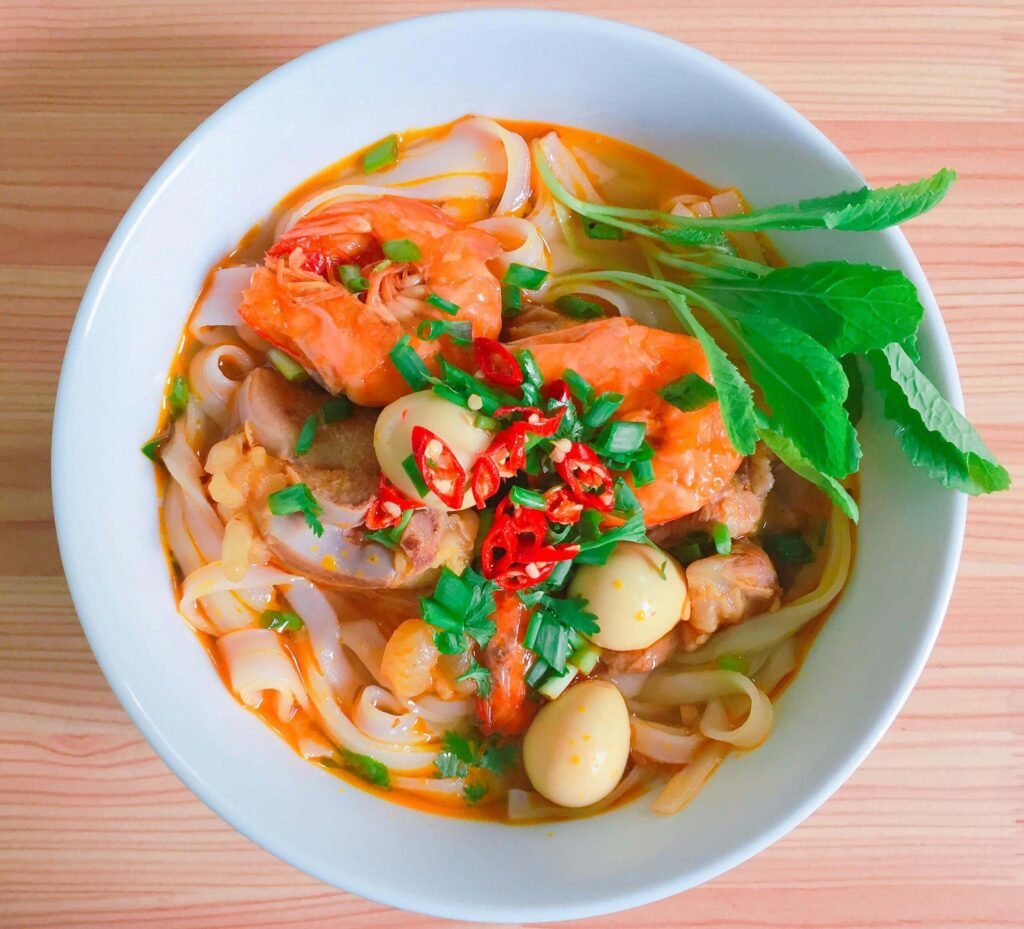
Personalizing Vietnamese Cuisine
Personalizing Vietnamese dishes while maintaining authenticity can be achieved by adjusting flavors to suit personal preferences, substituting ingredients based on dietary needs, or presenting dishes in creative ways. This allows for a unique and personal touch to traditional Vietnamese cuisine.
One way to personalize Vietnamese dishes is by adjusting the flavors. Vietnamese cuisine is known for its delicate balance of sweet, sour, salty, and spicy flavors. However, not everyone enjoys all of these flavors in equal amounts. For example, some people may prefer their food less spicy or more tangy. As a personal chef, it is important to understand your client’s preferences and adjust the flavors accordingly while still staying true to the essence of Vietnamese cuisine.
Another way to personalize Vietnamese dishes is by substituting ingredients based on dietary needs. With more people becoming health-conscious and following specific diets such as veganism or gluten-free, it is essential to be able to adapt traditional recipes. Instead of using fish sauce, a staple ingredient in Vietnamese cooking, you can use soy sauce or a vegan-friendly fish sauce alternative to make your dishes suitable for vegetarians or vegans. Similarly, rice noodles can be swapped for zucchini noodles for those who are avoiding gluten.
Vietnamese Food for Personal Chefs
In conclusion, exploring and cooking Vietnamese cuisine offers an exciting culinary journey. By understanding its key ingredients, techniques, and cultural significance, we can bring the authentic taste of Vietnam to our clients’ dining tables.
Here are some of my favorite tools for providing my personal chef service
As an experienced personal chef, I’ve found that the secret to creating mouthwatering dishes goes beyond just having a passion for food. It’s also about using the right kitchen tools. Today, I’m going to share with you my must-have kitchen items that help me bring my culinary creations to life.
1. Chef’s Knife
The first item on my list is a high-quality chef’s knife. It’s the most versatile tool in my kitchen, perfect for chopping, slicing, and dicing. My preference is for a Global Chef’s Knife, known for the edge and the way they are balanced.
2. Cast Iron Skillet
Next up is a good old cast-iron skillet. From searing steaks to baking cornbread, this pan does it all. I love the Lodge Cast Iron Skillet, which retains heat beautifully and adds a nice crust to anything you cook.
3. Stainless Steel Pots and Pans
A set of stainless steel pots and pans is essential for a variety of cooking techniques. They’re great for simmering, boiling, and sautéing. All-Clad’s Stainless Steel Cookware Set is my go-to choice for its exceptional performance and durability.
4. Immersion Blender
An immersion blender makes pureeing soups, making smoothies, and blending sauces a breeze. I suggest the Braun Multiquick Hand Blender, which is powerful, easy-to-clean, and highly versatile.
5. Digital Thermometer
To ensure perfectly cooked meats every time, a digital thermometer is a must. The ThermoPro TP19 Waterproof Digital Meat Thermometer provides speedy and accurate readings, ensuring your roast chicken or prime rib is cooked to perfection.
6. Silicone Spatula
A silicone spatula is a chef’s best friend for its versatility. It’s heat-resistant, non-stick, and perfect for everything from folding batter to stirring sauces. I recommend the OXO Good Grips Silicone Spatula.
7. Stand Mixer
Lastly, for avid bakers, a stand mixer is a game-changer. The KitchenAid Artisan Series 5-Qt. Stand Mixer isn’t just a pretty face; it makes mixing doughs and batters effortless.
These are the tools that I use daily in my personal chef service. Remember, quality tools make a difference, but they don’t have to break the bank. Start with the basics and add on as you grow more comfortable and adventurous in the kitchen.
Happy cooking!
